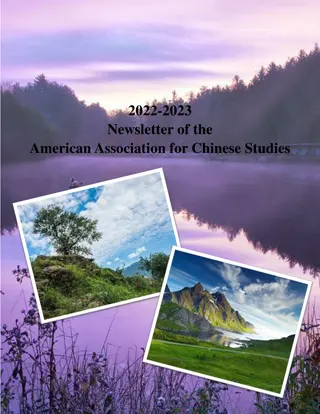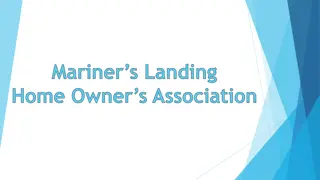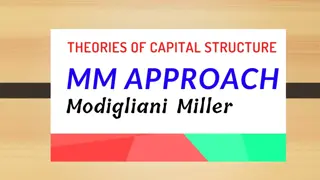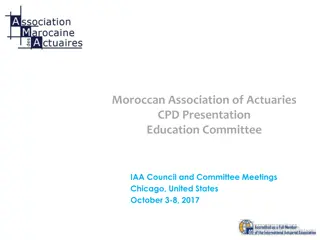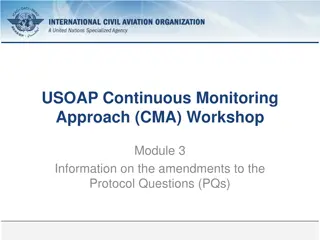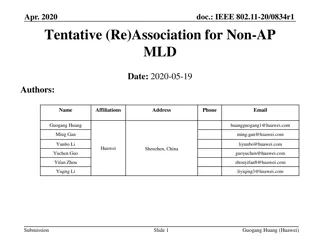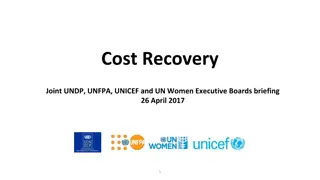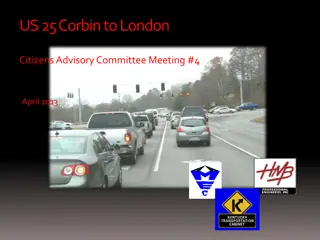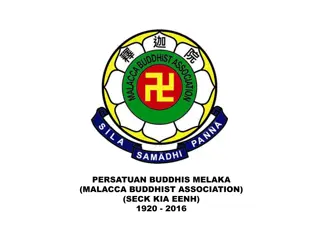Overview of the New COST Approach and Recent Changes in COST Association
COST (CO-operation in Science and Technology) facilitates networking activities for European researchers to collaborate on various scientific disciplines. The recent changes in COST Association introduced a new set of rules for proposal submission and evaluation, focusing on streamlining procedures and covering new and multiple topics. Additionally, the new scientific classification system categorizes research areas into 6 main fields and 41 sub-fields. Overall, COST offers an easy, flexible, and efficient funding scheme for research networks across Europe.
Download Presentation

Please find below an Image/Link to download the presentation.
The content on the website is provided AS IS for your information and personal use only. It may not be sold, licensed, or shared on other websites without obtaining consent from the author.If you encounter any issues during the download, it is possible that the publisher has removed the file from their server.
You are allowed to download the files provided on this website for personal or commercial use, subject to the condition that they are used lawfully. All files are the property of their respective owners.
The content on the website is provided AS IS for your information and personal use only. It may not be sold, licensed, or shared on other websites without obtaining consent from the author.
E N D
Presentation Transcript
The new COST approach first experiences, highlights and future possibilities ESF provides the COST Office through a European Commission contract COST is supported by the EU Framework Programme
What is COST? COST (CO-operation in Science and Technology) is a pan-European intergovernmental framework dedicated to networking activities for European researchers, enabling them to jointly develop their own ideas and new initiatives across all scientific disciplines through trans-European coordination of nationally funded research activities.
COST Features Easy funding scheme: one instrument (COST Action*) Bottom-up (researcher driven, any topic/multiple topics) Flexible (adaptable research and activities) Open participation (involve all stakeholders, type of institutions, career levels, countries, any time) Output oriented (open science, wide/free dissemination of knowledge and results, open access, open innovation) Efficient and cheap (compared to national research it leverages, sharing resources/infrastructure) * 300 running Networks of researchers: from min 5 COST countries, responding to an Open Call for proposals, based on a MoU, 4 years duration, implemented via networking activities
Recent changes The COST Association was established in 2013 as an international non-profit organisation. The governance and the operations are now integrated under the CA who is now the recipient of the Commission s grant. A new Scientific advisory body was put in place: the Scientific Committee
Recent changes New set of rules, in particular: a new process for submission, evaluation, selection and approval of proposals, put in place following an expert review, with the objective of streamlining the procedures and answering the demand to cover new & multiple topics. The previous scientific structuring in 9 Domains was consequently replaced by a new classification based on the OECD S&T classification (Main Fields/Subfields/research areas aiming at covering the whole spectrum of research topics).
New scientific classification Three level classification 6 Main Fields of Science: - Natural Sciences, - Engineering and Technology, - Medical and Health Sciences, - Agricultural Sciences, - Social Sciences, - Humanities 41 Sub-fields of Science 719 areas of expertise (research areas)
New scientific classification Widely implemented at COST (expert, proposal, Action level) Proposers can specify up to 5 areas of expertise Evaluators will be selected on the basis on the areas of expertise they entered in their profile Flexible approach: no permanent bodies (ad-hoc Review Panels per collection as clustering changes for each collection - depending on the proposals) But: a clustering of Actions is needed (possibly also on a ad-hoc basis) a.o. to allow them to meet and share their experience
New scientific classification: Supporting multi-disciplinarity Main Fields of research (MF) oc-2015-1 oc-2015-2 Proposals Actions Proposals Actions 4 MF 3 MF 2 MF 1 MF Total number 3% 10% 33% 54% 345 3% 13% 30% 55% 40 1% 11% 34% 53% 240 0% 19% 39% 42% 26
Recent changes A new COST member joined COST in 2015: Montenegro (COST has now 36 Full Member States and one Cooperating State).
Core policies in line with the challenges COST has undertaken in Horizon 2020 Excellence and inclusiveness (widening the European research base) Geographic pillar (pockets of excellence, Inclusiveness Target Countries) Career pillar (ECI Capacity building leading roles, access to STSM/TS) Gender pillar International cooperation (mutual benefit, NNC, ) Industrial dimension (open innovation) 1. 2. 3.
Key figures 2015 More than 25000 supported researchers Number of reimbursed participants in networking activities (meetings, workshops, STSM, Training Schools)
Key figures 2015 37% ECI* participating in networking activities Number of reimbursed Early Career Investigators participating in networking activities (meetings, workshops, STSM, Training Schools) * ECI = Researchers between PhD and PhD+8years 12
Key figures 2015 41% women participating in networking activities Number of reimbursed women participating in networking activities (meetings, workshops, STSM, Training Schools) 13
Key figures 2015 Almost 3000 Short Term Scientific Missions (STSM) 96% percent participants indicated improved career opportunities as a consequence of their participation
Key figures 2015 269 Training Schools (more than 4300 supported Trainees and 1200 Trainers)
COST Near Neighbour Countries 273 participations in running COST Actions across 16 countries Albania (31) Algeria (8) Armenia (15) Azerbaijan (1) Belarus (8) Egypt (9) Georgia (8) Jordan (4) Lebanon (5) Moldova (8) Morocco (16) PalestinianAuthority (6) Syrian Arab Republic (2) Russia (68) Tunisia (22) Ukraine (62) Status January 2016 16
International Partner Countries 546 participations in running Actions across 37 countries Status January 2016 17
Type of Institution among Action Management Committee participants 18
Recent changes: cooperation with Joint Research Centre (JRC) A Memorandum of Understanding with the Joint Research Centre has been signed in 2015 A increased participation of the JRC is expected in COST Actions in areas of common interest COST is expected to increase its impact on the Commission s Rtd Agenda
COST positioning (Research maturity vs Integration) Program networks Integration Project Networks COST Actions Individual Scientist Market and Societal application Applied research Innovation Basic research
Complementarity: ERC Grants and MSCA COST as stepping stone for young researchers Following the COST Impact Assessment dating back to 2014, 22 COST participants had received an ERC grant
Synergies: public partnerships/joint programming (member-state initiatives) Expertise of COST as Intergovernmental framework with a long experience in managing research networks (business model) at the service of joint programming initiatives/ transnational projects Young networks in emerging topics can inspire future member-state networks. (Importance of our communication with the member-states)
Summary: Strategic goals contribution to the ERA COST supports Inclusive research (geography, age, gender): provide opportunities for less established researchers to the benefit of a wider European research base Contribute to find emerging topics that can eventually be addressed through national research and European framework programmes Promote S&T cooperation with other countries Promote open innovation in COST Actions and contribute to increase the uptakes of research results by SMEs/industry
Get COST News by e-mail by signing up at www.cost.eu/notification COST European Cooperation in Science and Technology Avenue Louise 149 1050 Brussels, Belgium opencall@cost.eu Facebook www.facebook.com/COST.Programme twitter.com/COSToffice www.cost.eu www.linkedin.com/groups?gid=1699127




